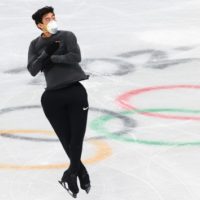
(NEW YORK) — Social media phenom is figure skating for change and representation
Figure skating at the Olympics is set to kick off on Friday, starting with the team event’s men’s singles short program.
There will be five types of figure skating events at the 2022 Beijing Winter Olympics: men’s individual, women’s individual, pairs, ice dancing and the team event. The events will run through Feb. 19, ending with the pairs free skate event.
Here, we break down what you need to know about figure skating, from how it’s scored to the jumps and spins required.
Scoring
The Olympics competition follows the International Judging System, which was established by the International Skating Union (ISU), the governing body for competitive ice skating sports, including figure skating, synchronized skating and speed skating.
Skaters earn technical scores and program components scores, which are added together to determine the score they got for the segment. Scores from the short program and free skating segments are then added to give the total score.
Skaters accumulate points based on the degree of difficulty of each element and how well each element is executed, according to US Figure Skating.
A technical panel — made up of a technical controller, technical specialist, assistant technical specialist, data operator and video replay operator — is tasked with identifying each element performed by skaters and its level of difficulty.
The judging panel is made up of a maximum of nine judges all tasked with scoring the quality of each technical element made and the five program components for each skater. The five components are: skating skills, transitions, performance, composition and interpretation of music.
Judges give a score for each component on a scale of 0.25 to 10, in increments of 0.25, with 10 being the best. The highest and lowest scores are thrown out and the remaining scores are averaged, and then multiplied by a set factor.
Different kinds of jumps and spins have different requirements, such as the number of rotations and edges used, in order to be performed correctly.
Points are deducted from skaters for any infractions they make. Deductions can be made for time violations, costume violations, illegal elements, falls during the program, interruptions of the program, late starts and not performing elements, according to the requirements of the programs.
The number of penalty points vary based on the kind of penalty made, according to ISU rules.
Skaters can also earn bonus points for jump elements performed during the second half of their program.
Spins
In order for it to qualify, a spin needs a minimum of two revolutions without interruption. There are three basic spin positions — a camel, sit or upright spin — and each can be performed a number of ways.
In a camel spin, one leg is on the ice while the other is lifted behind the skater with the knee higher than hip level. In a sit spin, the upper part of the leg not on the ice needs to be at least parallel to the ice. Upright spins are performed in any position with one leg extended or slightly bent, but not in a camel position.
There are also non-basic positions, such as a layback spin, where the skater is upright while their head and shoulders are leaning backwards with the back arched, and the sideways-leaning spin, where the skater is upright and their head and shoulders are leaning sideways with their upper body arched.
Spin combinations need at least two different basic positions with two revolutions each. Changing to a non-basic position is not considered a change of position.
Short programs need to include a flying spin, a spin in one position and a spin combination with only one change of foot. In the free skate, skaters need to have a maximum of three spins, with one of each: a spin combination, a flying spin or a spin with a flying entrance, and a spin with only one position.
Jumps
Jumps in competitive-level figure skating generally fall into two categories: edge jumps and toe jumps. To perform edge jumps, skaters rely on the blades of their skates to get off the ice, while toe jumps require skaters to use their toe pick to get in the air.
The edge jumps are the loop, the salchow and the axel, while the toe jumps are the toe loop, the flip and the lutz.
Each jump is assigned a different number of points depending on difficulty level.
Part of the difficulty level involves the number of rotations skaters make in the air. Triple-jumps require three or three and a half rotations in the air, and quadruples require four revolutions.
Jumping elements can be solo jumps, jump combinations and jump sequences. In a jump combination, the landing foot has to be the takeoff foot of the next jump, while jump sequences are made up of two jumps beginning with any jump and followed by an axle jump with a direct step from the landing curve of the first jump.
In the short program, skaters need to perform two solo jumps and a jump combination. Skaters need to include seven jumping elements in the free skate.
Copyright © 2022, ABC Audio. All rights reserved.















